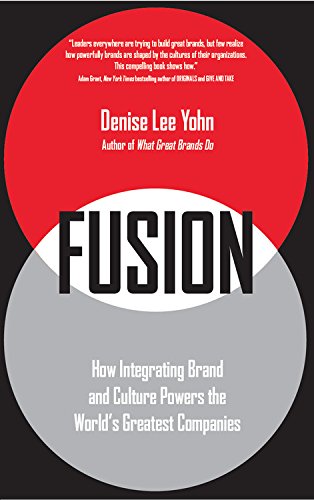 Take a peek behind the curtain at Amazon, Southwest Airlines and other hugely successful companies and you’ll find one thing they have in common: They blend their workplace culture with their brand so seamlessly that one is indistinguishable from the other. In her new book, Fusion: How Integrating Brand and Culture Powers the World’s Greatest Companies, brand-building expert Denise Lee Yohn explains how companies of any size can achieve success if leaders follow the right steps towards integrating their brand with their culture. She was a guest on the Knowledge at Wharton show on SiriusXM channel 111, where she discussed why companies must practice what they preach.
Take a peek behind the curtain at Amazon, Southwest Airlines and other hugely successful companies and you’ll find one thing they have in common: They blend their workplace culture with their brand so seamlessly that one is indistinguishable from the other. In her new book, Fusion: How Integrating Brand and Culture Powers the World’s Greatest Companies, brand-building expert Denise Lee Yohn explains how companies of any size can achieve success if leaders follow the right steps towards integrating their brand with their culture. She was a guest on the Knowledge at Wharton show on SiriusXM channel 111, where she discussed why companies must practice what they preach.
An edited transcript of the conversation follows.
Knowledge at Wharton: Take us into the idea behind bringing culture and brand together. When did it start?
Denise Lee Yohn: Brands have always been built by more than external communications. My first book, What Great Brands Do, talked about how great brands start inside, meaning they start brand-building by cultivating a strong brand-led culture, because culture is what determines whether you deliver on your brand promise. But as I started to work more and more with my clients, I found the ones that were more successful were the ones that saw the need to align and integrate brand and culture. The ones that didn’t were the ones that kept them very separate. That’s what led me to this book.
For many of these successful companies, it’s almost intuitive or integrated into the way they think and approach their business. They know they have to be on the inside what they say they are on the outside, so it becomes very natural for some business leaders to run the organizations that way. But for many others, they separate the two. They delegate brand-building to marketing and delegate culture-building to human resources, and never the two shall meet. That creates a big gap between how a company wants to be perceived, and how it really is.
Knowledge at Wharton: What’s the impact when a company doesn’t bring those two sides together?
“Companies have to be on the inside what they say they are on the outside.”
Yohn: It can really damage a company. Take the recent scandal at Wells Fargo, where it was revealed that employees were opening fake credit card and banking accounts for their customers. Employees were doing this because they were under incredible pressure to make certain numbers that their management had set for them. While that alone is a disturbing practice, I think what was particularly surprising was that this was coming from Wells Fargo, which is a company that always had this very wholesome brand image. They had the stagecoach, the old-fashioned logo, and the holiday ads with snowmen working hard to get your packages to your kids on time.
Even through the financial crisis, Wells Fargo had maintained a solid reputation as a very wholesome, values-oriented company. We now find out what the company was really like. There’s a real loss of trust that happens. In fact, I saw recently that Wells Fargo dropped from being in the top 20% of brands in customer trust to the bottom half. But what’s more is their financial performance. I think their net income dropped 5%, while the average of all other U.S. banks rose 14%. They lost market share in most states.
This disconnect has serious ramifications. Even if the consequences aren’t that serious, there can be a lot of waste. I think a lot of companies realize that culture-building is important, but they waste a lot of time and money and effort buying foosball tables for their break rooms and offering free beer on Fridays. Those things are fine. They might make your employees happy, but they’re not necessarily going to make your employees produce the results that you want.
Knowledge at Wharton: What about a company like Nike, which is a huge global brand and a leader in sports apparel? The company has had to deal with a number of issues over the years, including poor working conditions in foreign countries where some of its materials are produced.
Yohn: That’s when having a strong purpose and a strong set of values comes into play. When you have those or when you state those, and you’re not necessarily operating by them, people will call you on the carpet. Fortunately, Nike was able to turn around these poor practices to the point where they are now one of the leaders in advocating and ensuring that workplace conditions are healthy and sustainable.
You need to start off with asking, “What do we believe in? What do we want to hold ourselves accountable for? And what do we want to tell our customers and other stakeholders that you can expect from us?”
Knowledge at Wharton: How can companies fuse culture and brand?
Yohn: I wrote this book because I think there’s a lot of rhetoric out there about culture-building but not a lot of instruction. What can you as a business leader do? The book outlines how you lay the foundation for achieving brand-culture fusion, and then it goes through five steps or strategies that you can take to achieve it.
“You can’t mandate your culture.”
Two things on the foundation: One, you need to have an over-arching purpose and a single set of core values for your organization. Why do you exist? How are you going to operate? You want those to be unique so that you are reinforcing the things that are going to distinguish you as a company and as a brand. The second foundation element is for the business leader to take responsibility for culture-building. Oftentimes, it’s seen as something that business leaders can delegate to other folks or think that it happens kind of organically. It’s quite to the contrary. You need to be very deliberate both in your actions and your communication, and then take these five steps.
The first step is to organize and operate on brand. Use your organizational design and your operational processes to cultivate your cultural priorities.
The second strategy is to create culture-changing employee experiences. Just as you want to deliberately design customer experience, you want to deliberately design your employee experience so that your employees experience the culture that you’re planning.
Third is to sweat the small stuff in the way you run your company — your policies, your procedures, your rituals, artifacts — all the little things can add up to make a big impact on your culture.
The fourth strategy is to ignite your transformation through employee-brand engagement, not just general employee engagement but really engaging employees with your brand.
The fifth strategy is to build your brand from the inside out. Look for ways that you can use your culture to differentiate and define your brand.
Knowledge at Wharton: Let’s go back to the employee experience. The experience that the employee has is an unbelievably vital piece to business success, but it’s also important because the company invests in finding those employees.
Yohn: Those are two reasons why it is so critical for you to engage in employee experience design and management. I’ll add a third, which is that you can’t expect your employees to deliver to customers what they don’t experience themselves. If you want your employees to treat your customers with grace and respect and service and humility, but you’re beating down your employees every day, good luck with that. Maybe a less extreme example would be if you want to create a customer experience that is technology-enabled and seamless and integrated, but your employees are struggling with tons of paperwork and outdated systems, they’re not going to be able to translate what you want them to do into that customer experience.
Knowledge at Wharton: Going back to core values, it’s good that more companies are talking about that because it wasn’t always a topic of conversation in the past.
“Look for ways that you can use your culture to differentiate and define your brand.”
Yohn: It was just assumed that people would know to do the right thing or know what the company’s values were. But a couple of things have happened. One, there has been a lot more turnover and fluidity in the workforce, so you don’t have people who stay with your company over a long period. You don’t have that kind of organizational glue that naturally happens. Two, your customers and other people from the outside have way more visibility into your company now. They are starting to question, “What are your values? How are you operating? What distinguishes you from someone else?” They want to know if there’s something unique about your company that would influence their purchasing habits.
Knowledge at Wharton: Who are some of your best examples of companies that have really figured this out?
Yohn: One of my favorites is Amazon. The reason I talk a lot about Amazon is because I think that most people have some negative associations with Amazon’s corporate culture arising from The New York Times article that was written a couple of years ago. But what was really interesting is that as many people who criticized Amazon for having what The Times called a “bruising and painful culture,” many others came to Amazon’s defense and said, “No, this is an exciting and inspiring culture.” A lot of the existing employees at Amazon said, “We are pushed to challenge ourselves and challenge each other, but that’s a good thing.” That culture of innovating and performing and challenging is what defines Amazon both as a business and as a brand. The reason why we all love Amazon is because they are so focused on innovating for their customers. We benefit as customers, and employees benefit because they are all working towards that same goal.
Knowledge at Wharton: Is the idea of what makes a good culture specific to each company, or can it be generalized?
Yohn: One of the common problems or misperceptions that I find across business leaders is they assume that they need to have one kind of culture. There is a lot written about companies like Southwest, so you think you need to have warm, friendly, fun leaders who joke around a lot and seem to have a party all the time. That works for Southwest Airlines, but it’s not going to work for a company that needs to be much more standards-, metrics- and performance-driven. Just as it would be ridiculous to try to imitate someone else’s brand, you don’t want to imitate someone else’s culture.
Knowledge at Wharton: What is the most important thing for leaders to understand from your book?
Yohn: I think it is this idea of being unique and doing the hard work to cultivate that unique culture. You can’t mandate your culture. You can’t force your employees to work in a certain way. But you can set up the environment through organizational design, through your employee experience, through all these things that cultivate the certain kind of culture that you want. But it’s not going to happen if you don’t take responsibility for it, if you don’t drive it, if you don’t champion it.



